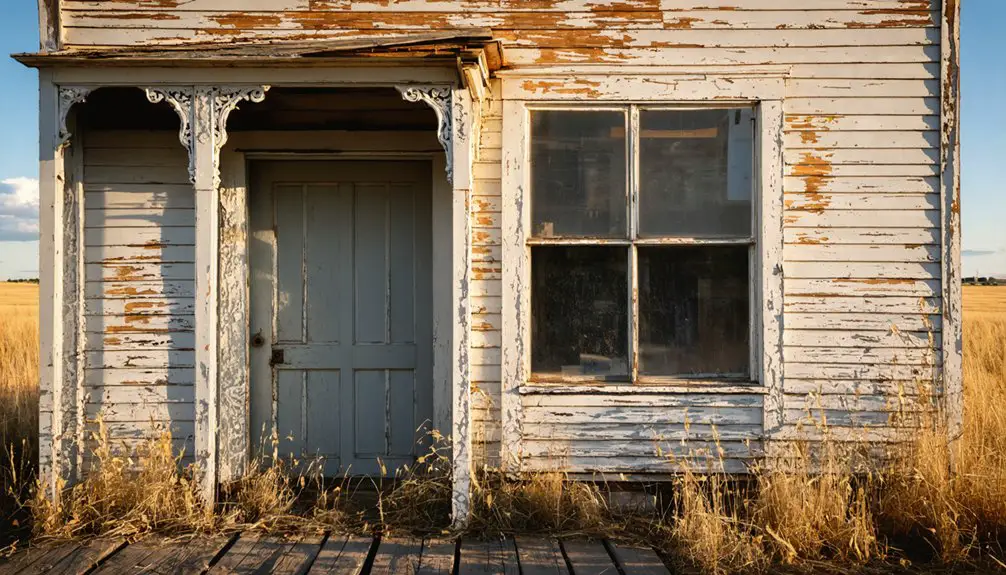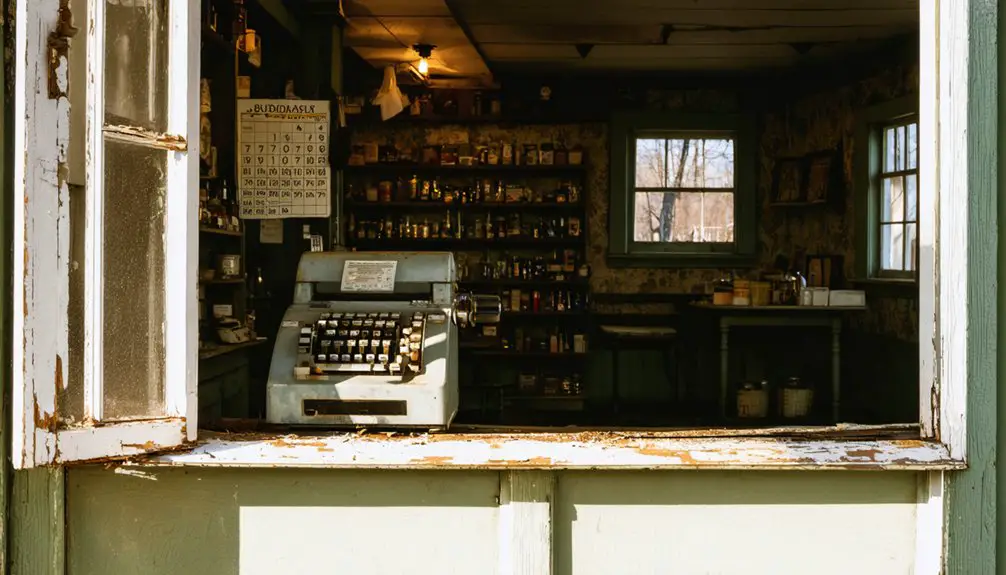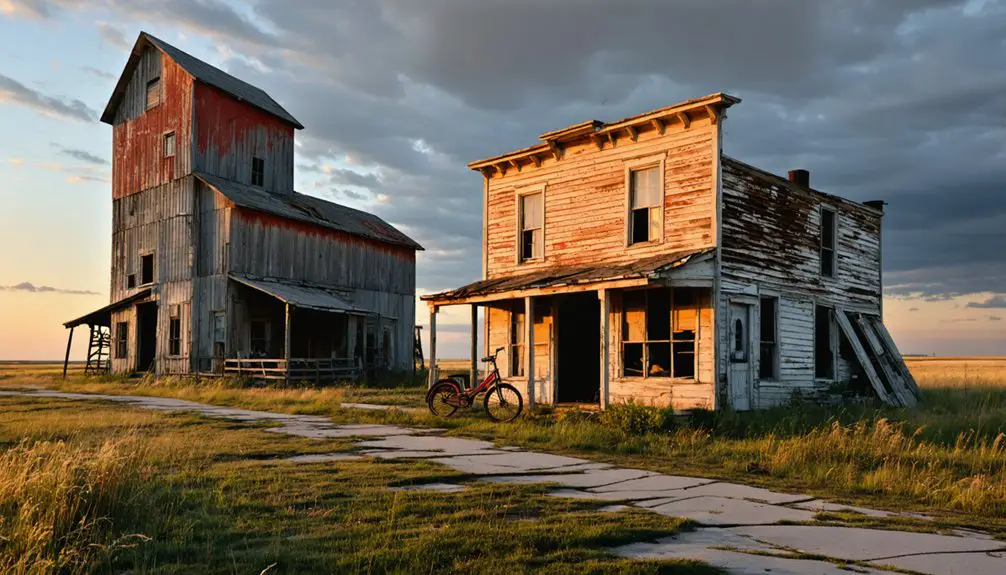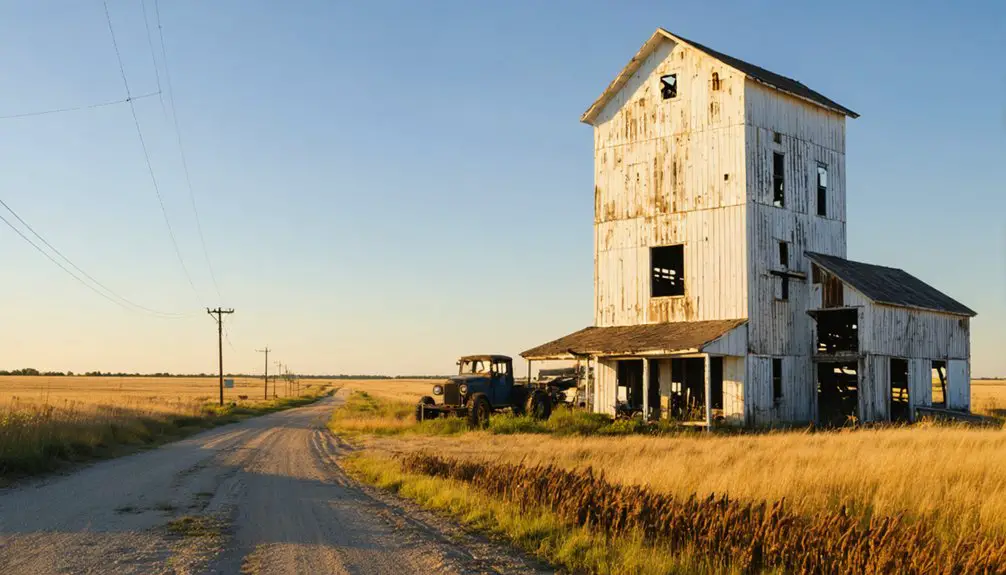You’ll find Sherbrooke, North Dakota‘s ruins scattered across Steele County’s prairie landscape, where this former county seat once thrived in the 1880s. After peaking at 303 residents in 1910, the town’s fortunes declined when the Great Northern Railroad built its line five miles north, and the county seat moved to Hope in 1919. Today, only deteriorating structures remain, including the relocated Sherbrooke House Hotel where President McKinley once stayed. The town’s untold stories linger in its crumbling foundations and windswept fields.
Key Takeaways
- Sherbrooke was established in 1881 by Norwegian, Canadian, and American settlers, reaching its peak population of 303 residents by 1910.
- The town served as Steele County’s seat from 1885-1919, featuring a courthouse, thriving businesses, and the notable Sherbrooke House Hotel.
- President McKinley’s 1896 stay at Sherbrooke House Hotel marked a highlight in the town’s history before its decline.
- The town’s decline began when the Great Northern Railroad bypassed it by five miles, leading to economic isolation.
- Today, Sherbrooke stands as a ghost town with scattered ruins, agricultural fields, and few remaining structures marking its former existence.
The Birth of a Prairie Town (1881-1885)

Three distinct immigrant groups – Norwegians, Canadians, and Americans – converged to establish Sherbrooke, North Dakota in 1881 following the platting of the village and township.
Named after its Quebec counterpart, the settlement quickly took shape as pioneers like Tobias Johnson staked their claims along Beaver Creek at “Tobias Slough.”
Early settler experiences centered around building essential infrastructure, including three schoolhouses and the five-bedroom Sherbrooke House Hotel, which would later host President McKinley.
Early pioneers focused on vital community buildings, with schoolhouses and the historic Sherbrooke House Hotel serving distinguished guests like President McKinley.
The township’s formal organization in 1885 brought structured governance under Chairman T. H. Anderson and his fellow supervisors.
That same year, Sherbrooke gained prominence as the Steele County seat, spurring construction of a courthouse that doubled as the community’s social hub.
County Seat Glory Days
While Sherbrooke’s designation as Steele County seat in 1885 marked a pivotal moment in its history, the years that followed brought unprecedented growth and civic development to this prairie settlement.
The town’s commitment to community governance flourished with the construction of a county office building in 1886, which was expanded just two years later to meet growing demands.
You’ll find these remarkable indicators of Sherbrooke’s civic engagement during its glory days:
- A bustling downtown filled with thriving storefronts and blacksmith shops
- A diverse population of Norwegian, Canadian, and American settlers
- Peak township population reaching 303 residents by 1910
- Strong political influence as the administrative hub of Steele County
These golden years of prosperity would continue until 1919, when rail transportation access ultimately determined the town’s fate.
Life at the Sherbrooke House Hotel

You’ll find President William McKinley‘s 1896 overnight stay at Sherbrooke House Hotel meticulously documented in the establishment’s preserved guest records.
The five-bedroom hotel, owned by “Ma Elliott,” mother of the local sheriff, provided travelers with modest but essential lodging services during Sherbrooke’s peak as county seat.
Daily operations centered around hosting political figures, business travelers, and townspeople who gathered to exchange news and participate in community functions tied to the nearby courthouse.
Considered a prestigious destination, the Steele County seat remained at Sherbrooke until losing its status in 1919.
The town’s influence began to fade when county seat status was lost in 1919.
McKinley’s Historic Stay
Among the most significant events in Sherbrooke’s history was President William McKinley‘s stay at the Sherbrooke House Hotel in 1896. The hotel, owned by “Ma Elliott,” stood as a symbol of Sherbrooke’s brief prominence as the county seat of Steele County.
McKinley’s legacy in this small North Dakota town highlighted the hotel’s significance as a hub for political and social activity.
- The five-bedroom hotel served as one of the main lodging places for travelers and dignitaries.
- You’ll find the hotel’s history preserved through local historical accounts.
- The building represented Sherbrooke’s importance during its county seat status from 1885 to 1919.
- The hotel later moved north, marking the town’s shift toward ghost town status.
This presidential visit remains a defining moment in Sherbrooke’s historical identity, even as the town declined after losing its political influence.
Daily Hotel Operations
Despite its modest size of five bedrooms, the Sherbrooke House Hotel operated as a bustling establishment under the management of “Ma Elliott” during the late 1800s.
You’d find a small but dedicated staff handling guest interactions, from check-ins to basic meal service, while coordinating with local businesses to meet visitor needs.
Daily operations faced unique operational challenges without railroad access, yet the hotel served as a crucial stopover for traveling salesmen, county officials, and settlers.
Staff prepared rooms, maintained the property, and likely facilitated informal gatherings in public areas. They’d work closely with the town’s infrastructure, including the courthouse and stage line, to guarantee smooth service delivery.
The hotel’s efficient management helped maintain Sherbrooke’s status as a functioning county seat throughout this period.
Missing Rails: The Fatal Transportation Gap
While Sherbrooke once served as the proud county seat of Steele County from 1885 to 1919, its fate was sealed when the Great Northern Railroad chose to build its line five miles north of the town in 1896.
The devastating transportation challenges and economic isolation that followed led to the town’s eventual demise as a thriving community.
- Early railroad survey stakes gave false hope, with farmers plowing around them for years before realizing expansion would never come.
- The town’s peak population of 303 residents in 1910 quickly declined as businesses relocated to better-connected areas.
- Without rail access, local farms and businesses couldn’t compete with nearby railroad towns’ superior market access.
- The final blow came in 1919 when the county seat moved to Hope, a town along the railroad line.
Community Heartbeat: Social Life and Business

During Sherbrooke’s heyday, you’d find the courthouse’s second story bustling with church services and ice cream socials, serving as the town’s primary gathering space.
The Sherbrooke House Hotel, featuring five bedrooms and boasting a presidential visit from William McKinley in 1896, stood as another vital social hub for the agricultural community.
Local businesses, including a blacksmith shop, grocery store, and stage line, supported the daily needs of Sherbrooke’s farming families while strengthening community bonds.
Like many ghost towns near Bismarck, Sherbrooke’s once-thriving community life has faded into historical memory.
Vibrant Courthouse Social Events
The grand Sherbrooke courthouse, completed in 1886, served as the beating heart of local social life, transforming from a mere legal institution into the town’s vibrant community hub.
Beyond its official duties, the courthouse hosted countless social gatherings that brought the community together in meaningful ways.
- Public debates and votes on county matters sparked intense social interactions, drawing residents from across the region.
- Community fairs, dances, and political rallies regularly animated the courthouse grounds.
- Business owners and residents networked before, during, and after courthouse events.
- The Sherbrooke House Hotel, which hosted President McKinley in 1896, flourished from courthouse-related visitors.
The building’s 1888 expansion reflected its growing importance as the epicenter of civic engagement and social connection, where courthouse gatherings shaped the town’s identity until its eventual decline in 1919.
Small Businesses Support Community
In late 19th century Sherbrooke, small businesses formed an intricate network that sustained both economic and social life within the rural community. You’d find crucial services like blacksmith shops and stage lines, while the Sherbrooke House Hotel, run by “Ma Elliott,” welcomed notable guests including President McKinley in 1896.
These establishments fostered community engagement beyond their commercial roles. The courthouse’s second story transformed into a venue for church gatherings and ice cream socials, demonstrating the economic interdependence between business and social functions.
Family-operated enterprises served as essential meeting points where farmers could gather, trade, and maintain community bonds. The town has remained vacant for decades, with no residents calling Sherbrooke home since the early 1990s.
Despite Sherbrooke’s eventual decline due to limited railroad access, these businesses initially provided the foundation for a thriving rural settlement, shaping both its identity and early development patterns.
The Slow Fade: From Hub to Ghost Town
Once a bustling county seat with aspirations of becoming a regional hub, Sherbrooke’s transformation into a ghost town unfolded through a series of critical setbacks between 1885 and 1919.
You’ll find that economic factors and demographic shifts dealt crushing blows to this once-promising settlement.
- The town’s isolation from railroad networks severely limited its growth potential and trade capabilities.
- Loss of county seat status to Finley in 1919 stripped away essential administrative functions.
- The symbolic departure of the town’s hotel, which once hosted President McKinley, marked deepening decline.
- Agricultural mechanization reduced the need for large rural populations, accelerating the town’s abandonment.
Today, you’ll discover only abandoned buildings slowly returning to nature, as Sherbrooke stands as a representation of how transportation access and political status can determine a town’s fate.
What Remains: Exploring Present-Day Sherbrooke

Visitors to present-day Sherbrooke will find little more than scattered ruins and agricultural fields where a thriving county seat once stood. The handful of abandoned structures that remain are steadily deteriorating, with nature and agricultural reclamation slowly erasing the town’s physical footprint.
Even the historic hotel where President McKinley once stayed has been relocated north of its original location.
You’ll discover no maintained paths, visitor facilities, or clear markers to guide your exploration. The surrounding farmland has consumed most of the original townsite, with farmers plowing over old town plots and railroad stakes.
While you can freely access the area, you’ll need to envision the once-bustling community through the few dilapidated buildings that still dot the prairie landscape.
A Legacy Written in Prairie Winds
Though Sherbrooke’s physical structures have largely crumbled, its historical legacy endures through a rich tapestry of stories, archives, and cultural memory.
The town’s cultural significance stems from its role as an essential agricultural hub and county seat, where farmers and townspeople forged a community amid the challenging prairie landscape.
- You’ll find traces of President McKinley’s 1896 visit to the Sherbrooke House Hotel, a proof of the town’s former prominence.
- You can discover the story of “Ma Elliott,” whose influence shaped local social life.
- You’ll learn how farmers plowed around abandoned railroad stakes, symbolizing lost dreams of connectivity.
- You can explore courthouse records that document the agricultural impact of early settlers who transformed the prairie into farmland.
Frequently Asked Questions
Was Sherbrooke Ever Considered for Connection to Other Transportation Routes Besides Rail?
You won’t find historical evidence of transportation alternatives beyond rail – records don’t show any serious consideration of canals, major highways, or other routes of historical significance for Sherbrooke’s connectivity.
What Happened to the Courthouse Records When the County Seat Moved?
With 100% of courthouse records at stake, you’ll find they were transferred to Finley in 1918-1919 during the county seat relocation, ensuring continuous record preservation for legal and administrative needs.
Are There Any Descendents of Original Sherbrooke Residents Still Living Nearby?
You’ll likely find descendant stories continue through scattered farming families in Steele County, though direct family ties aren’t well documented. Check historical societies and courthouse records for confirmation.
Did President Mckinley’s Visit Have Any Lasting Impact on the Town?
You won’t find any lasting McKinley influence on Sherbrooke. His overnight stay didn’t spark economic growth or prevent the town’s decline. The visit remains just a historical footnote in ghost town records.
Were There Any Notable Crimes or Significant Legal Cases in Sherbrooke?
You won’t find any documented notable crimes or legal disputes in the town’s history. The available records show no major criminal cases during its time as county seat.
References
- https://news.prairiepublic.org/show/dakota-datebook-archive/2022-06-09/sherbrookes-decline
- https://www.onlyinyourstate.com/experiences/north-dakota/ghost-towns-nd
- https://northernsentry.com/2023/05/12/ghosts-of-north-dakota/
- https://www.theflashnites.com/blog/exploration-stories/the-ghosts-of-sherbrooke-north-dakota/
- https://us1033.com/a-haunting-look-at-some-real-life-north-dakota-ghost-towns/
- http://genealogytrails.com/ndak/steele/twphistory.html
- https://en.wikipedia.org/wiki/Sherbrooke_Township
- https://www.nd.gov/government/state-government/county-history
- https://ghostsofnorthdakota892857007.wordpress.com/2013/10/27/return-to-sherbrooke/
- http://genealogytrails.com/ndak/steele/townhistories.html



